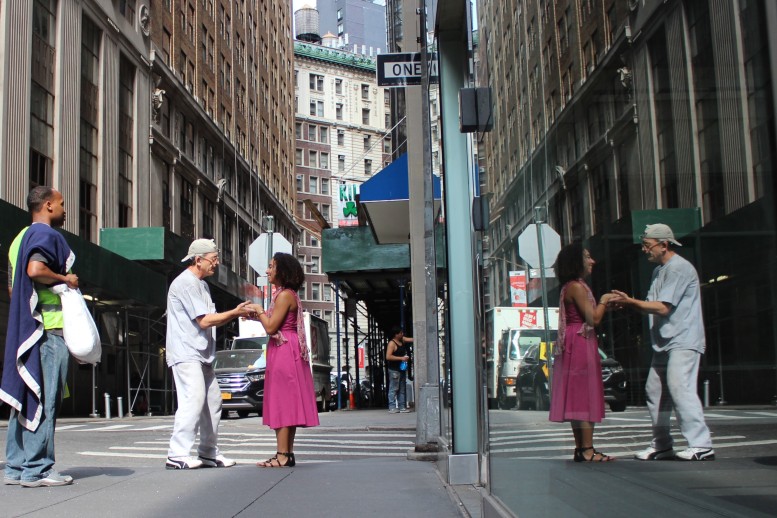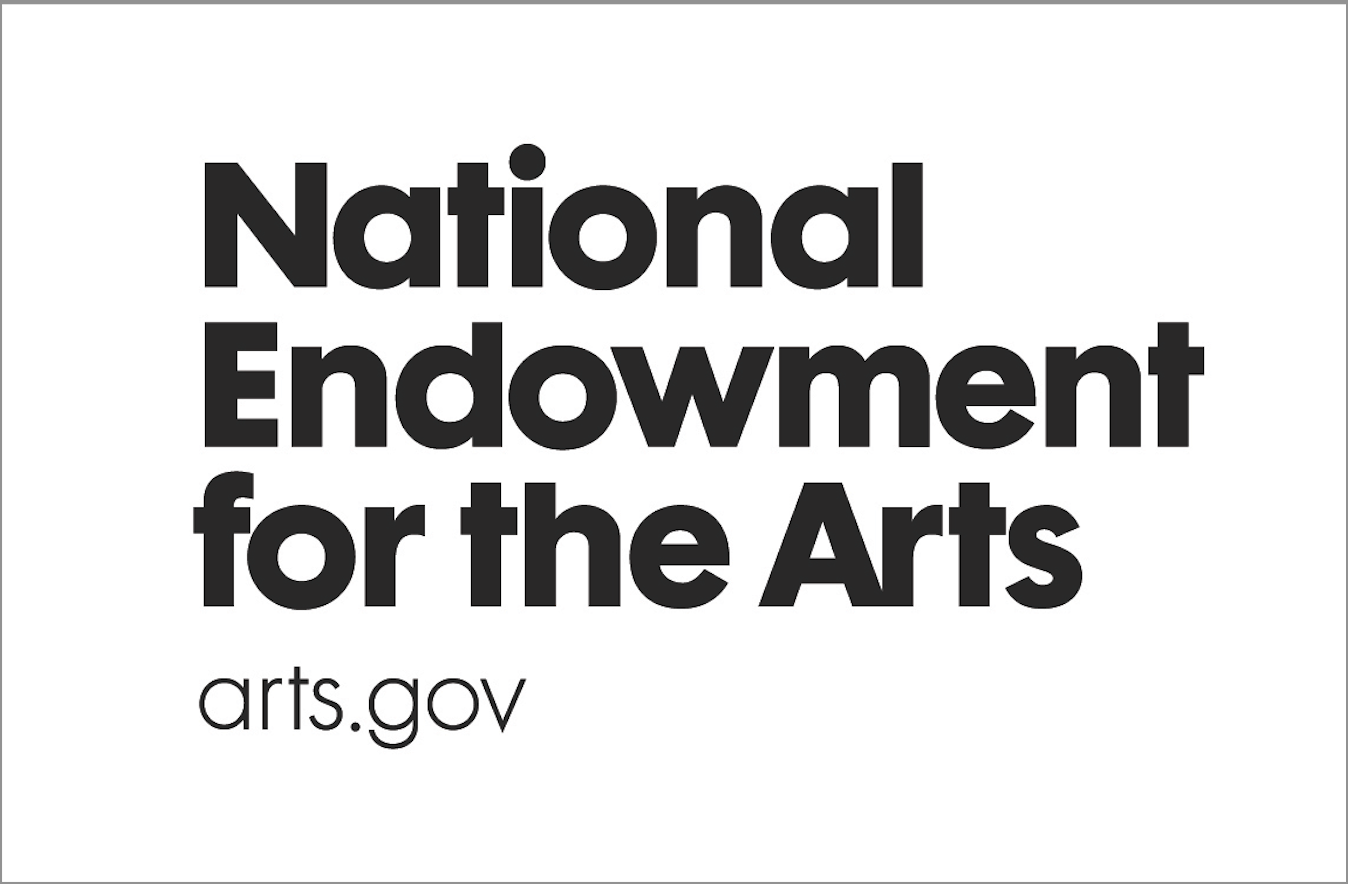The concept for “Broken City” came to life in 2012 when Tamilla Woodard, Ana Mărgineanu and I decided to create a piece of theater that could exploit the uniqueness of different parts of the city and the bustle of the streets of New York while offering a very intimate experience to our audiences. Since performance space is so expensive in New York and the city offers a new world within every block, we thought it would be the perfect context to create what we began to call a “street immersive.” So we started to put together all of our ideas and explore what “Broken City” would be, the types of storytelling we might try in the streets and with an audience that was to be constantly on the move. We decided to go to a specific neighborhood every time and research it before creating the plays.
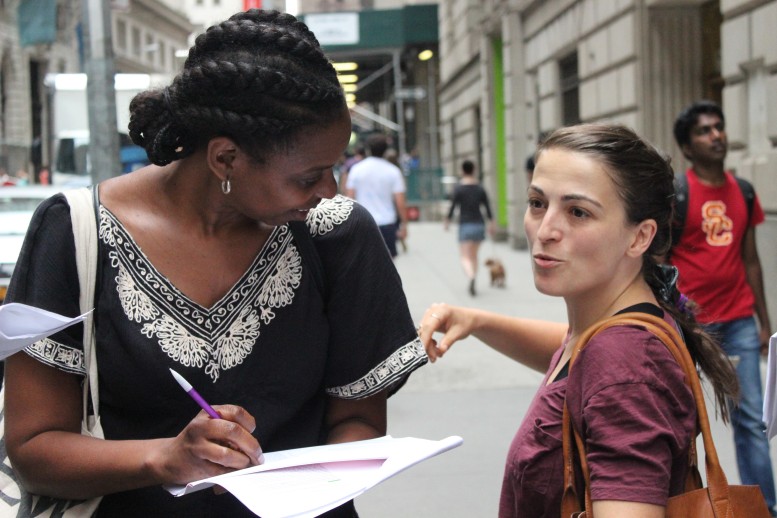
Directors Tamilla Woodard and Ana Mărgineanu discuss a scene in “Broken City: Wall Street.” Photo Credit: Alex Sollitto
The first time around we were on the Lower East Side. We created five simultaneous stories, each of them in a different performance convention. Each dealt with the very special feel of this true immigrant neighborhood and its challenges in a wildly gentrifying environment.
The second time around, we explored the rich stories of Harlem, with our guest playwright Sandra A. Daley-Sharif and our guest director Ebony Golden. Harlem is also a neighborhood faced with many challenges brought by fast gentrification, trying to keep its identity alive. In Harlem, we had five routes again, five stories, and continued to experiment with new storytelling conventions.
For all of us in PopUP Theatrics, the first two “Broken City” editions were extraordinary learning experiences, each of them fascinating in their own right. For the third one, however, we all wanted to try to make it even more structurally and narratively cohesive. So we chose one of our favorite conventions — “Broken Life Of…” — where we follow one character on a day in their lives while having narrators giving us insight on the inner life of the characters, their past history, and their hopes and dreams.
Unlike Lower East Side or Harlem, Wall Street doesn’t have a gentrification problem. It was historically a place for trade (including slave trade in its more distant history), business, wild speculation, and the engine of the American Dream. Wall Street’s identity is always in the present, despite its huge scar, the fall of the World Trade Center in 2001.
In the Financial District the buildings are so high, and the streets so narrow, that sometimes you’re unable to see the sun. If you look close enough, surreal landscapes pop up all the time. Like you’re in Fritz Lang’s “Metropolis.” There have been quite a few films telling Wall Street stories recently, but they all dealt with finance. Our goal was not to explore the same themes as “The Wolf of Wall Street,” or “The Big Short,” but to go to the root and see what the regular people working or living in the area are going through on a daily basis. We observed, talked to, and interviewed everyone from street vendors to financial workers. In the end, we found quite a few fascinating, very personal stories in our research which were used as a source of inspiration for building the fictional stories in our show.
Very quickly, we concluded that the main theme of “Broken City: Wall Street” should be how people relate to their time (the past, present, and future), as Wall Street is a very strong mix of the three. Despite traumatic events in its recent past (9/11, the economic crisis), Wall Street still lives in the present and sells the future all the time.
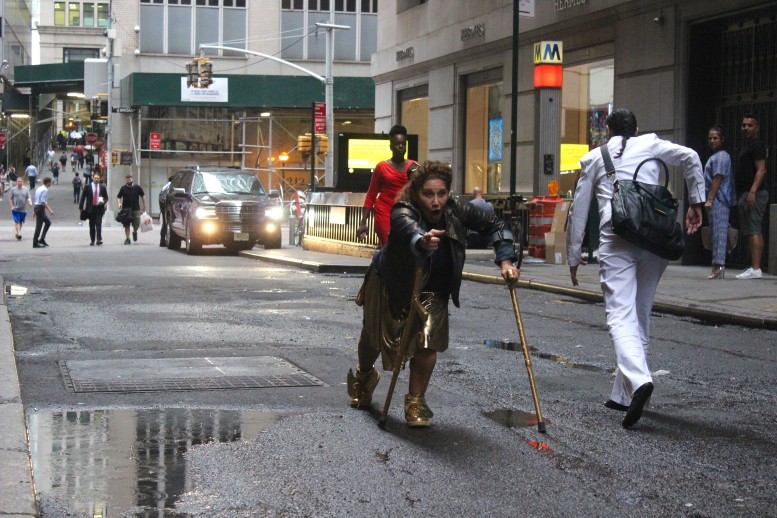
Isolte Avila moves through the streets during “Broken City: Wall Street.” Photo Credit: Alex Sollitto
In this year’s edition, we invited guest collaborators once again. David Bower and Isolte Avila, founding members of UK-based dance company Signdance Collective, brought a new perspective to the movement and storytelling, including completely “sign-dance-ing.” One of our stories, “The Past of ‘Fred’ W,” features David, himself. David is deaf and sight impaired. Isolte walks with the aid of two crutches but dances like she’s flying (also with the two crutches). They have transformed disability into extraordinary ability, and it’s been a profound experience for everyone on the team. It was a really nice challenge to incorporate their particular aesthetic and skills to take “Broken City” into new territory.
In this year’s “Broken City,” we have three main characters that deal with time. One is trapped in the past, trying to relive only the good memories in his life, but hiding from his present and his future, risking peril. Another character is suffering from a psychosomatic condition that makes her erase all her memories, thus being trapped in an everlasting present moment, seeing everything for the first time. And finally, we have a character constantly living in the future, planning everything while missing all the opportunities to just live in the present or enjoy her past.
These three characters inhabit the same time and space, the same moment of the day. For someone seeing all three stories, it would be like enjoying a novel. Through our narrators, we do have insight into characters’ thoughts. But we also have wonderful visual things happening all the time, all around, so at times it’s like being in the middle of your very own movie.
That is why performing in “Broken City” is such a unique experience. Our actors and performers have been telling us time and again about the joys of discovering the possibilities of the convention. For the ones playing narrators, there is always a bond, a partnership with the audience members. You have to be prepared to be in the moment, all the time, and meet the needs of your spectator partner. It’s not just telling a story, it’s creating a connection. And that connection works only if you are truthful all the time. You can’t just perform like usual, you have to perform in constant relation with an unknown person, who breathes and feels right next to you. You have to be ready to adjust and improvise within the world of the story but in relation to reality. And so many times extraordinary surprises come out of this partnership, as the audience members feel empowered as co-creators of the journey they’re on. They go home with the feeling they have also been a protagonist, a participant, an active observer in a story that unfolds in three dimensions around them. They might go home feeling this whole experience was made for them specifically. It gets very personal and subjective. And it stays with you after the performance. Often our audiences wonder what is performance and what is real, who’s a character and who, like them is a spectator, observer, passerby, unknowing participant in a moment.
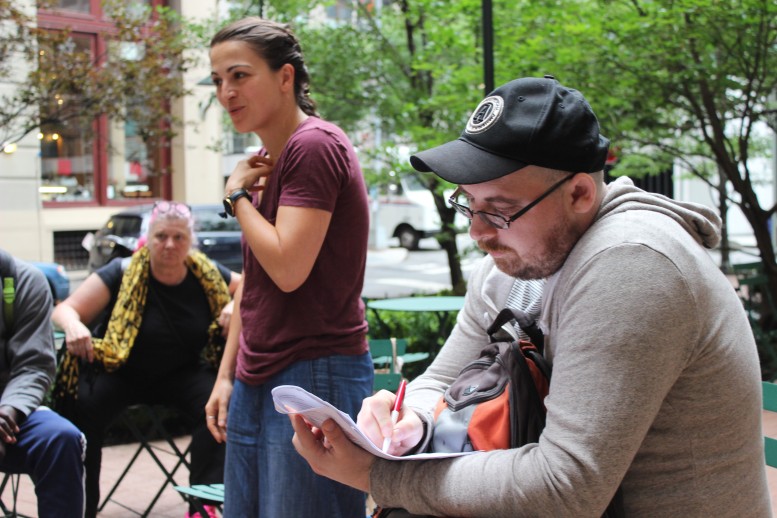
Ana Mărgineanu gives the “Broken City: Wall Street” cast direction as Peca Stefan takes notes. Photo Credit: Alex Sollitto
This indescribable closeness is also felt by our performers who don’t play the narrators but play the different parts characters that occupy each storyline. The audience is so close, all the time, it’s like performing in permanent close up. It’s all in the eyes. You have to be full and honest, committed and connected each second. It’s really exhausting, and our actors tell us, exhilarating. The audience can choose their proximity to the work. They can walk beside it, or behind it, they can sit with the character, hold the narrator’s hand, run down the street with us or lag behind — and we adjust. We tell the story according to the audiences chosen POV. So, the story, the part that each actor plays has to be deeply investigated to allow for such agility of storytelling. It’s the ultimate exercise in being. Even in our highly theatrical moments or farcical comedic moments, veracity is still key because it’s impossible to hide or lie. Sometimes, the street and outside interaction add unexpected layers to the context you’re performing that, so you need to be ready to instantly connect to those stimuli and use them in the story itself. This is the kind of performance work and learning that could only happen in this kind of immersive street theater.
“Broken City” has never been a naturalistic performance. We’ve had imaginary friends, witches, inner thoughts talking to you, magical encounters, The Church of Tell It Straight To My Face, all things that seek to bring a heightened perception to the surrounding environment. Ultimately, the main goal of “Broken City” — apart from offering audiences a truthful, surprising and immersive experience — is to make them see the city with new eyes. As simple pedestrians, we usually go without looking because we go to the same places every single day. Most of the times we miss out on so much.
Also as a theater artist, it’s so refreshing to be able to explore all the possibilities public spaces have to offer. It’s a very rich canvas available to you all the time in this concept. As a writer, you are writing a play, a novel, a film, a magic show, a street intervention, a musical and a movement piece all at the same time. As a director, you are making a comedy, a tragedy, a farce, a live book on tape but will real people, a site-specific work, a short film, and a lot of slight of hand. The performance may begin with a flash mob, but it becomes so intimate and incognito that you feel it belongs just to you, the one or two or four spectators on the trail. It is a hybrid, it is syncretic, and it is a very exciting way of looking at performance in a world that treasures individual experience more and more. We’re very excited to take this concept even further in the near future, also playing with what technology has to offer.
Post Views:
1,413
